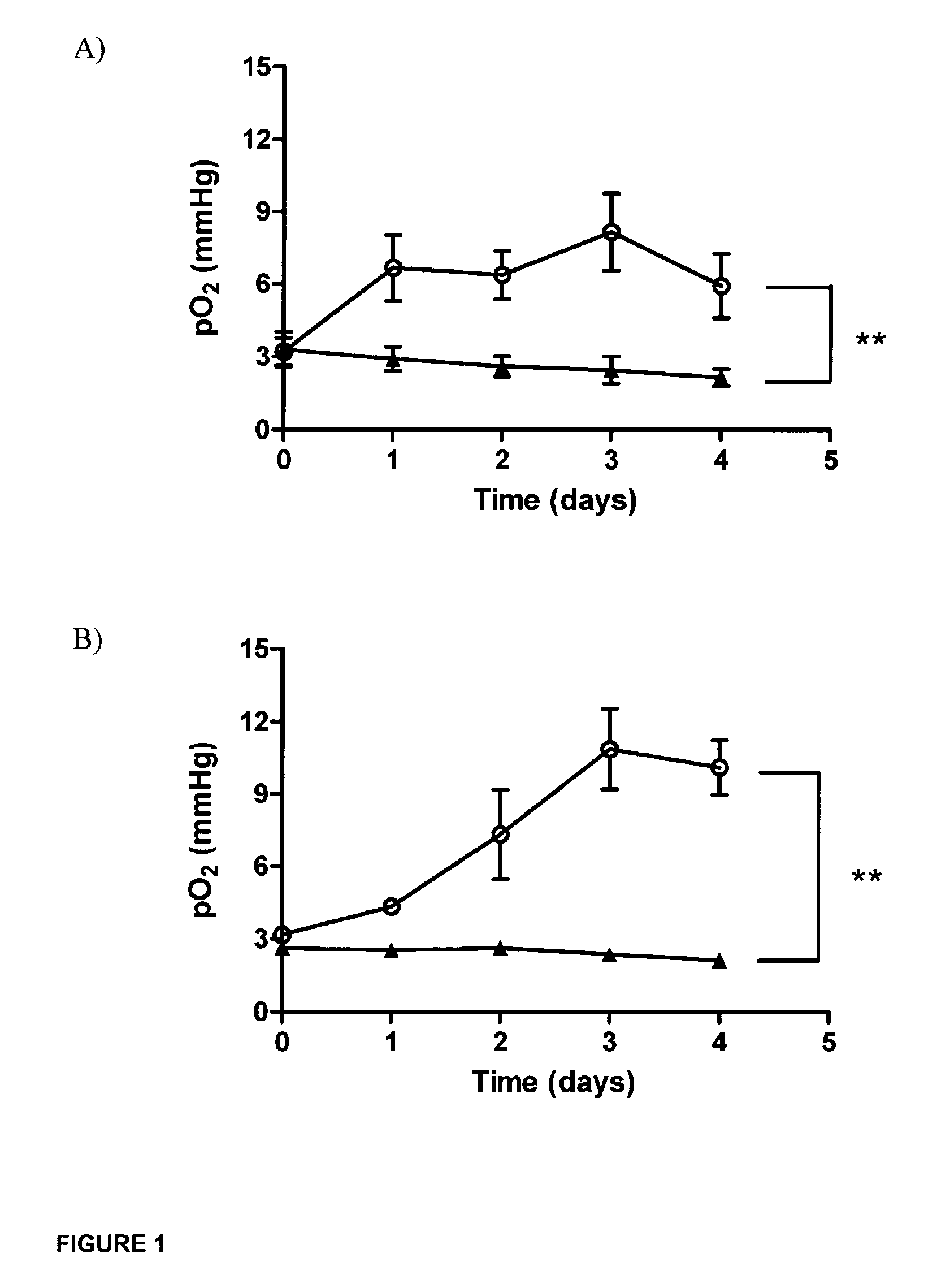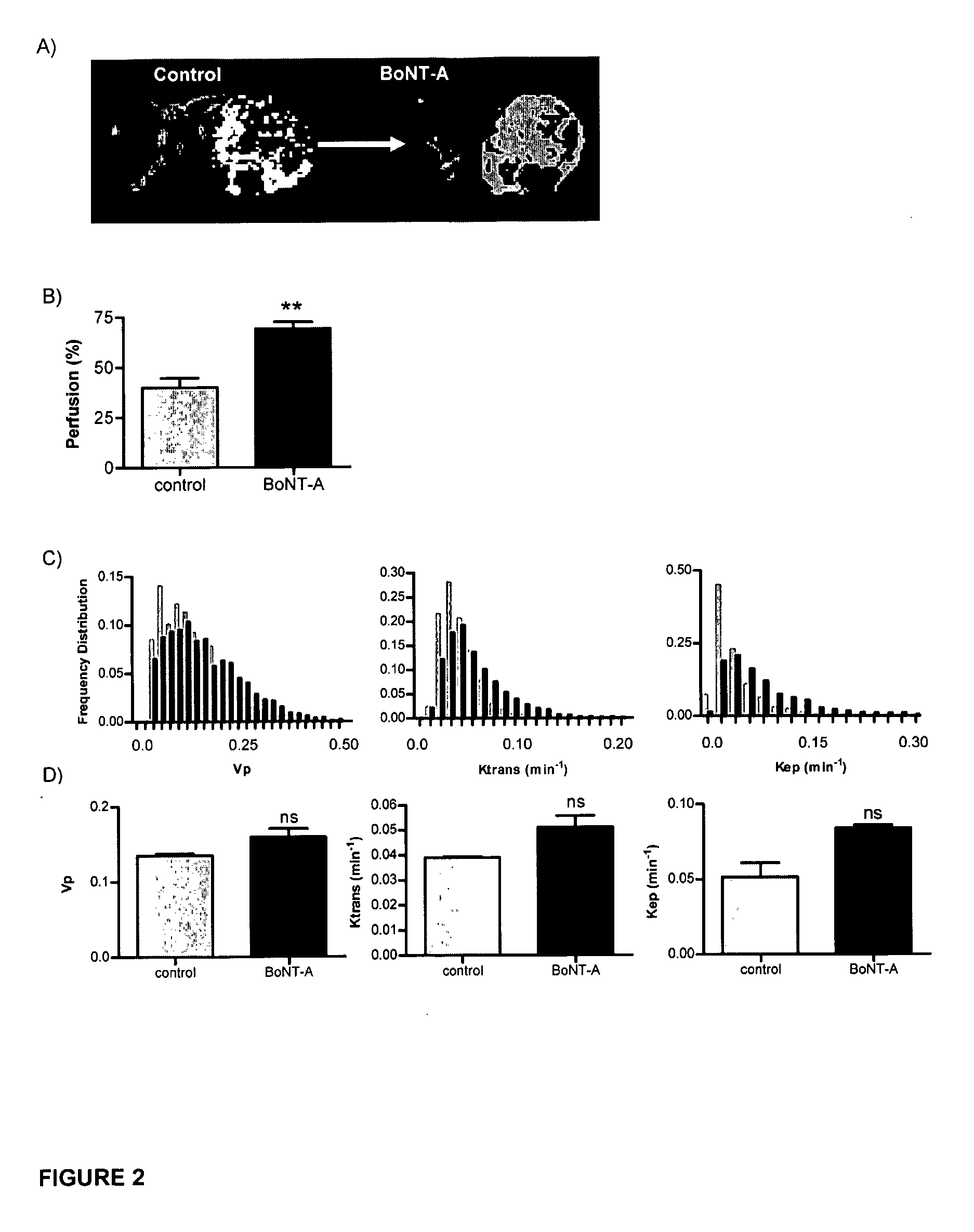Methods and compositions for the treatment of cancer
a cancer and composition technology, applied in the field of cancer compositions and methods, can solve the problems of ineffective surgical operations, ineffective treatment of cancer at later stages of therapy, and unsatisfactory combination cancer treatments
- Summary
- Abstract
- Description
- Claims
- Application Information
AI Technical Summary
Problems solved by technology
Method used
Image
Examples
example 1
Experiment 1
In Vivo Tumour Preparation
[0198]Two different tumour models were implanted in the thigh of mice: Syngeneic FSa II fibrosarcoma tumour cells were injected intramuscularly in male C3H / HeOuJlco mice and a Transplantable mouse Liver Tumour (TLT) model injected into NMRI mice. Both tumor models were previously characterised by the inventors for assessing the effect of treatments which potentiate radiotherapy and chemotherapy. Tumors were measured daily with an electronic caliper. For all experiments, tumor-bearing mice were anesthetized using isoflurane (2.5% for induction, 1% for maintenance). All animal experiments were conducted in accordance with national animal care regulations.
[0199]BTTA (i.e. Botox®) or saline solution (control) was injected when tumours reached a diameter of 6.5±1.0 mm. Botox® (Allergan, Antwerp, Belgium) was dissolved in saline water and was given via intratumoural injections of 40 μl total. A 20 μl injection was performed at two different places in ...
experiment 2
Tumour Oxygenation
[0200]Electronic Paramagnetic Resonance (EPR) Oximetry using charcoal (CX0670-1, EM Science, Gibbstown, N.J.) as oxygen sensitive probe was used to evaluate tumour oxygenation changes after treatment with BTTA. EPR spectra were recorded using an EPR spectrometer (Magnettech, Berlin, Germany) with a low frequency microwave bridge operating at 1.2 GHz and extended loop resonator. Mice were injected in the centre of the tumour 1 day before measurement using the suspension of charcoal (suspension in saline containing 3% Arabic gum, 100 mg / ml, 50 μl injected, 1 to 25 μm particle size). The localized EPR measurements correspond to an average of pO2 values in a volume of ˜10 mm3. In order to avoid any acute effect of the treatment, data acquisition was made before the injection of BTTA or saline and then on a daily basis.
experiment 3
Flow Measurements
Patent Blue Staining.
[0201]Patent Blue (Sigma-Aldrich, Bornem, Belgium) was used to obtain a rough estimate of the tumour perfusion three days after administration of the BTTA or vehicle. This technique involves the injection of 200 μl of Patent Blue (1.25%) solution into the tail vein of the mice. After 1 min, a uniform distribution of the staining through the body was obtained and mice were sacrificed. Tumours were carefully excised and cut in two size-matched halves. Pictures of each tumour cross-section were taken with a digital camera. In order to compare the stained with unstained area, an in house program running on IDL (Interactive Data Language, RSI, Boulder, Colo.) was developed. For each tumour, a region of interest (stained area) was defined on the two pictures and the percentage of stained area of the whole cross-section was determined. The mean of the percentage of the two pictures was then calculated and was used as an indicator of tumour perfusion.
Dy...
PUM
| Property | Measurement | Unit |
|---|---|---|
| particle size | aaaaa | aaaaa |
| volume | aaaaa | aaaaa |
| inner diameter | aaaaa | aaaaa |
Abstract
Description
Claims
Application Information
 Login to View More
Login to View More - R&D
- Intellectual Property
- Life Sciences
- Materials
- Tech Scout
- Unparalleled Data Quality
- Higher Quality Content
- 60% Fewer Hallucinations
Browse by: Latest US Patents, China's latest patents, Technical Efficacy Thesaurus, Application Domain, Technology Topic, Popular Technical Reports.
© 2025 PatSnap. All rights reserved.Legal|Privacy policy|Modern Slavery Act Transparency Statement|Sitemap|About US| Contact US: help@patsnap.com



